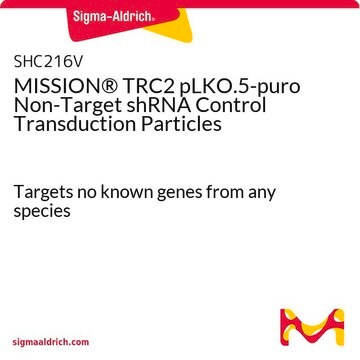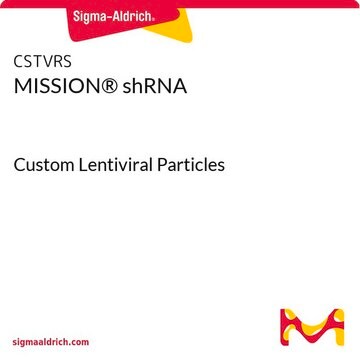SHC002V
MISSION® pLKO.1-puro Non-Mammalian shRNA Control Transduction Particles
Targets no known mammalian genes
Sinónimos:
MISSION®, MISSION® Control Transduction Particles
About This Item
Productos recomendados
Quality Level
product line
MISSION®
concentration
≥1x106 VP/ml (via p24 assay)
technique(s)
capture ELISA: 106 TU/mL using p24
shipped in
dry ice
Storage temp.
−70°C
¿Está buscando productos similares? Visita Guía de comparación de productos
Categorías relacionadas
General description
Small interfering RNAs (siRNAs) expressed from short hairpin RNAs (shRNAs) are a powerful way to mediate gene specific RNA interference (RNAi) in mammalian cells. The MISSION product line is based on a viral vector-based RNAi library against annotated mouse and human genes. shRNAs that generate siRNAs intracellularly are expressed from amphotropic lentivirus viral particles, allowing screening in a wide range of mammalian cell lines. In these cell lines, MISSION shRNA clones permit rapid, cost efficient loss-of-function and genetic interaction screens.
The lentiviral transduction particles are produced from an shRNA lentiviral non-target control plasmid. It is useful as a negative control in experiments with the MISSION shRNA target sets.
Unlike murine-based MMLV or MSCV retroviral systems, lentiviral-based particles permit efficient infection and integration of the specific shRNA construct into differentiated and non-dividing cells, such as neurons and dendritic cells,1 overcoming low transfection and integration difficulties when using these cell lines. Self-inactivating replication incompetent viral particles are produced in packaging cells (HEK293T) by co-transfection with compatible packaging plasmids.2-3
In addition, the lentiviral transduction particles are pseudotyped with an envelope G glycoprotein from vesicular stomatitis virus (VSV-G), allowing transduction of a wide variety of mammalian cells.4 The lentiviral transduction particles are titered via a p24 antigen ELISA assay and pg/ml of p24 are then converted to transducing units per ml using a conversion factor. The conversion can be viewed at: www.tronolab.com.
To see more application data, protocols, vector maps visit sigma.com/shrna.
application
Legal Information
Optional
Storage Class
12 - Non Combustible Liquids
wgk_germany
WGK 3
flash_point_f
Not applicable
flash_point_c
Not applicable
ppe
Eyeshields, Gloves, multi-purpose combination respirator cartridge (US)
Certificados de análisis (COA)
Busque Certificados de análisis (COA) introduciendo el número de lote del producto. Los números de lote se encuentran en la etiqueta del producto después de las palabras «Lot» o «Batch»
¿Ya tiene este producto?
Encuentre la documentación para los productos que ha comprado recientemente en la Biblioteca de documentos.
Los clientes también vieron
Artículos
Methods for lentiviral transduction of Jurkat cells were compared. Spinoculation was compared with overnight incubation with polybrene (hexadimethrine bromide) and fibronection-coated plates.
Methods for lentiviral transduction of Jurkat cells were compared. Spinoculation was compared with overnight incubation with polybrene (hexadimethrine bromide) and fibronection-coated plates.
Methods for lentiviral transduction of Jurkat cells were compared. Spinoculation was compared with overnight incubation with polybrene (hexadimethrine bromide) and fibronection-coated plates.
Methods for lentiviral transduction of Jurkat cells were compared. Spinoculation was compared with overnight incubation with polybrene (hexadimethrine bromide) and fibronection-coated plates.
Protocolos
Detailed procedure for how to perform a lentiviral transduction of MISSION shRNA lentiviral particles to achieve a stable long term silencing and phenotypic change.
This detailed procedure allows you to transduce Mouse Embryonic Fibroblasts (MEF) using MISSION ExpressMag Super Magnetic Kit.
Nuestro equipo de científicos tiene experiencia en todas las áreas de investigación: Ciencias de la vida, Ciencia de los materiales, Síntesis química, Cromatografía, Analítica y muchas otras.
Póngase en contacto con el Servicio técnico











